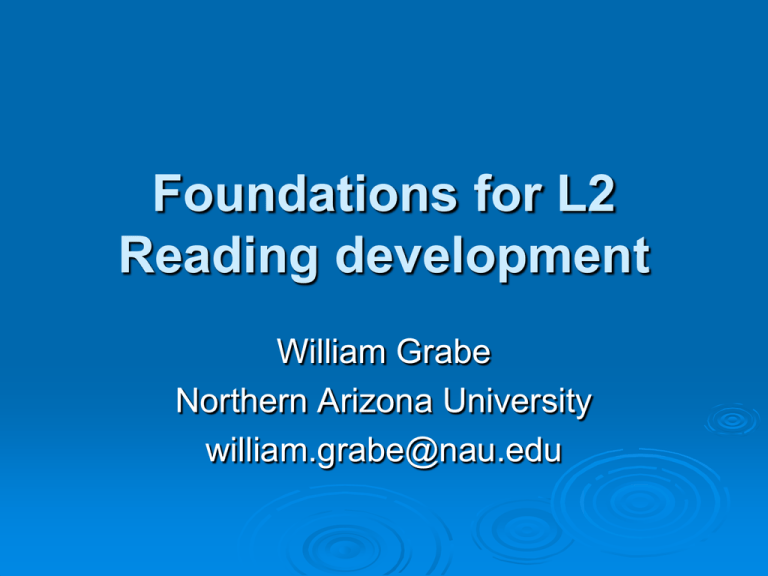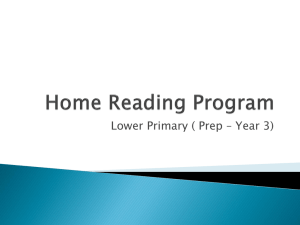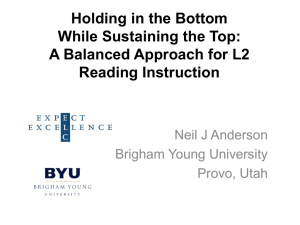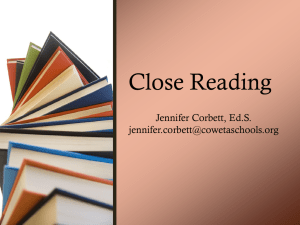William Grabe`s presentation here
advertisement

Foundations for L2 Reading development William Grabe Northern Arizona University william.grabe@nau.edu Introduction 1. 2. 3. 4. 5. 6. The miracle of reading Fluent reading and the reading comprehension process The reading construct as the goal for reading development Expertise and reading: Get a good coach Implications from research for reading instruction Curricular and instructional options for L2 reading development Defining Reading 1. 2. Reading is a complex ability to extract, or build, meaning from a text Reading is a synthesis of component skills including efficient processing, relevant knowledge bases, strategic processing, metacognitive awareness, and reading goals Reading Processes Lower level processes Higher level processes Processes influences by purposes for reading, motivation, the reading task, and text difficulty Learning to read: Combination of Incremental skill, expertise development, explicit instruction L1 and L2 Reading: Differences 1. 2. 3. 4. 5. 6. A much smaller L2 linguistic knowledge base Much less experience with L2 reading exposure Cognitive processing involving two languages A range of L1 transfer effects Differing combinations of background knowledge Distinct L2 social and cultural assumptions L1 and L2 Reading: Similarities 1. 2. 3. 4. 5. Same underlying cognitive processes More similar as proficiency increases More similar with closer L1/L2 linguistic distance More similar as higher level cognitive processes are called on (for challenging but appropriate academic tasks) Multiple processing paths to comprehension is true even within L1 groups of readers Implications from Research: What L2 students Need 1. 2. 3. 4. Decode graphic forms for efficient word recognition Access the meanings of a large number of words automatically Draw meaning from phrase and clause level grammatical information Combine clause level meanings to build a larger network of text comprehension Implications from Research: What L2 Students Need 5. 6. 7. 8. Recognize discourse level relationships that build and support comprehension Use reading strategies with more difficult text and for a range of academic reading tasks Set goals for reading and adjust them as needed Use inferences of various types and monitor comprehension in line with reading goals Implications from Research: What L2 Students Need Draw on prior knowledge as appropriate 10. Evaluate, integrate, and synthesize information from a text to form a situation model of comprehension 11. Maintain these processes fluently for an extended period of time 12. Motivate students to persist in reading and use text information appropriately for reader goals 9. Teaching L2 Reading 1. 2. 3. 4. Curriculum development principles for L2 reading Instructional practices to develop reading abilities A few demonstrations Combining language and content instruction Curricular Principles 1. 2. 3. 4. Integrate major skills instruction with extensive practice and exposure to print Use reading resources that are interesting, varied, good-looking, abundant, and accessible Provide some degree of student choice Introduce reading skills by examining the primary texts used in the reading course Curricular Principles 5. 6. 7. 8. 9. Connect text information to students’ background knowledge Develop lessons structured around prereading, during-reading, and post-reading Provide opportunities for students to experience comprehension success Build expectations that reading occurs in class every day or in every lesson Use teaching practices that support research implications Promote Word Recognition Skills 1. 2. 3. 4. 5. 6. Engage in extensive reading Read in every class lesson Read for fluency in class Reread texts for multiple purposes (recycling) Practice word recognition exercises (matching activities and word lists) Use flash cards and computer wordrecognition activities Build a Large Recognition Vocabulary 1. 2. 3. 4. 5. A practical theory of vocabulary learning (Velcro theory of vocabulary learning) Procedures for selecting words to focus on Techniques for introducing new words Ways to practice using words Activities to build word learning strategies Build a Large Recognition Vocabulary A vocabulary–rich environment to support learning 7. Activities that build student awareness of words 8. Activities to help students collect words 9. Ways to build motivation for word learning 10. Activities that recycle texts and vocabulary 11. Extensive reading 6. Practice Comprehension Skills 1. 2. 3. 4. 5. 6. Support knowledge of basic grammar for text comprehension Activities to identify main ideas in the text Activities that activate background knowledge Strategic processing with more difficult texts Discussions about text information (questions on how to understand the text) Extensive reading Practice Comprehension Skills Trans Fats in Trouble: Identify main idea sentences. Identifying Main Idea Sentences Here are my answers: Paragraph 1 – sentence 3 Paragraph 2 – sentence 1 Paragraph 3 – sentence 1 Paragraph 4 – sentence 1 Paragraph 5 – sentence 1 (?) Build Awareness of Text Structure 1. 2. 3. 4. Preview texts and highlight key words that signal text structure Highlight a paragraph; decide its function in the text Fill in an outline of the text and determine main units of the text Fill in a table, chart, graph, timeline, tree, graphic organizer, etc. Build Awareness of Text Structure Find patterns of discourse organization in a text (cause-effect, comparison-contrast) 6. Reorganize scrambled paragraphs and sentences to reassemble a text or to make a good summary 7. Remove wrong sentence from a summary or a paragraph 8. Match main ideas and supporting information across two columns 5. Build Awareness of Text Structure A text example: Trans Fats in Trouble Build Awareness of Text Structure Problem (para 1) Solutions (para 3-5) 1. Trans fats affect health (para 1) 2. Foods labeled for TF: Canada, US 3. 4. City voluntarily eliminates TF: Tiburon, CA 5. Build Awareness of Text Structure Problem (para 1) Trans fats affect health (para 1) Solutions (para 3-5) 1. Countries restrict TF: Denmark, Canada 2. Foods labeled for TF: Canada, US 3. City requires ban on TF in restaurant:NYC 4. City voluntarily eliminates TF: Tiburon, CA 5. States ban TF: CA, MA, MD, VT Becoming a Strategic Reading 1. 2. 3. 4. 5. 6. 7. Plan and form goals before reading Form predictions before reading Reread as appropriate Monitor reading continuously Identify important information Fill in gaps in the text through inferences and prior knowledge Make guesses about unknown words Becoming a Strategic Reading 8. 9. 10. 11. 12. 13. 14. Use text structure information to guide understanding Integrate ideas from different parts of the text Build main idea summaries Evaluate the text and the author Attempt to resolve difficulties Decide if reading goals are being met Reflect on the information in the text Teaching Strategic Reading 1. 2. 3. 4. Introduce a strategy, talk about how, when, and why to use it. Add strategy to a class list Verbalize strategies in combination so students “see” strategies being used Model strategic reading, provide scaffolding, give extensive practice, and encourage independent use of the strategies by students Focus discussions and questions on text comprehension Teaching Strategic Reading 5. 6. 7. 8. Promote comprehension monitoring Strategy instruction is a part of everyday instruction, and not separate lessons Eventually automatize strategy use for fluent reading Extensive reading strengthens strategic reading Practicing Passage Reading Fluency 1. 2. 3. 4. 5. 6. Reread texts used in class for multiple purposes Read with the teacher as the teacher reads aloud Timed reading activities Paced reading activities Rereading practice (recycling) with a text used for a class unit Extensive reading Practice Reading Fluency Trans Fats in Trouble: Oral Paired Repeated reading practice Rereading and Recycling 1. 2. 3. 4. 5. 6. 7. 8. 9. Reread text quickly to begin post-reading discussion Work with a graphic organizer Do a dicto-comp for part of a text Read to make a summary or fill in an outline Read 3-4 times as oral rereading fluency practice Read text, take a different position from author Read to look for text structure signals Read to look for signals for main ideas Read to connect to a previous text Developing Extensive Reading 1. 2. 3. 4. 5. Provide many attractive reading materials; have a good class library Provide time for free reading in class (ScSR) Explain goals of extensive reading and long term benefits of extensive reading Create many opportunities for all kinds of reading, including the Web Have a good class library Developing Extensive Reading 6. 7. 8. 9. 10. 11. Read interesting material to students Find out what students like to read and why Let students read magazines, comics, newspapers Create ways to interest student sin reading topics Talk about what you read and why; talk about why you like to read Have students share and recommend reading texts Motivating Students to Read 1. 2. 3. 4. 5. Talk about what interests you and why Have students share their interests Promote group cohesiveness Create communities of learners who support each other during difficult tasks Increase expectancy of success Motivating Students to Read Have good lead-ins for major texts and tasks; build initial interest 7. Match student skills with challenge 8. Make the curriculum relevant to students 9. Build real levels of expertise in topics of readings 10. Give students some choices within the curriculum 6. Language and Content Learning for Reading Development 1. 2. 3. 4. Begin from curricular goals and great text materials Teach component skills for reading within an integrated coherent curriculum Develop various language skills and resources (much as other curricular models would) Create opportunities for extended reading and recycling of prior texts in class Language and Content Learning for Reading Development 5. 6. 7. 8. Build motivational learning experiences Create increasingly complex tasks; growing challenges to match growing skills Incorporate project-based learning Generate needs to interpret, integrate, and evaluate information from multiple texts (good EAP tasks) Foundations for L2 Reading Development William Grabe Northern Arizona University william.grabe@nau.edu







